Founding of the Medici dynasty
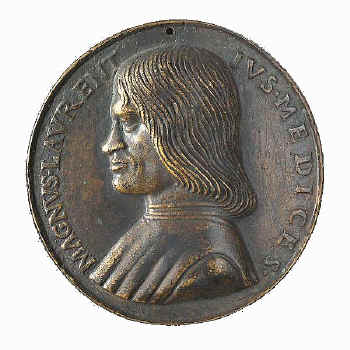
The founder of the Medici family as it emerged from obscurity was Giovanni, son of
Averardo (also called Bicci). He belonged to the Cafaggiolo branch of the family and he occupied the highest position in the
Popular Party. There he worked prudently and silently, in accordance with his mild, affable character. The Medici policy was always aimed at encouraging democratic aspirations, but the basic intention of the family was to turn those aspirations to their own advantage and to exploit them
in their own interest. Giovanni was a skillful banker and intelligent businessman, thoughtful and reserved. He didn't distinguish himself in dress or lifestyle. He lived simply in the serene peace of his family. Giovanni didn't like to be involved with public appointments, but he accepted to be "Priore"
(Prior) in Florence for three times.
His wealth brought him into contact with the nobility, to whom, nevertheless, he
was politically opposed, for he belonged to another aristocracy that counted in Florence - that of commerce and banking. Beneath a veil of apparent disinterest, he concealed a tenacious, intelligent will to
accumulate wealth, so that his patrimony might become an instrument of political power in his hands and in those of his successors. In 1386, Giovanni di Bicci married Piccarda Bueri and they had two sons: Cosimo and Lorenzo.
Cosimo, the elder of Giovanni's two sons, consolidated the Cafaggiolo branch of the Medici family, whereas
Lorenzo founded the Popolani line. When the Cafaggiolo's luck turned against
them and members of the family were persecuted and exiled, the Popolani rose to prominence on a platform of democratic reform, establishing a popular reputation as free citizens in a free city. Later, when the senior line of the family died out, they were entrusted with the government of Florence, which they administered in a ruthlessly undemocratic manner. Cosimo possessed his father's simplicity, patience and modesty.
Nevertheless, he was determined not to be just a rich banker with some political influence: his objectives included
political power. In just a few years, Cosimo dei Medici absorbed the majority of the thirty-nine Florentine banks, which had begun to disappear in 1425, while Giovanni was still alive. He placed this immense economic power at the service of his political ambitions, and naturally his conduct immediately made the other merchant bankers - the Strozzi, the Pazzi, the Acciaioli and above all the Albizzi - his enemies.
|
|
|
In 1434 Cosimo, who had come to a more and more prominent position in the political life of Florence, was exiled by
those who opposed him, being accused of having attacked Florentine freedom. He was
recalled one year later, his position was consolidated and he governed for thirty years without ever receiving an official title. Cosimo's court was, like that of his immediate successors, a gathering of artists and scholars, whose works were among the most prized possessions of the family and the city - figures of stature of
Donatello, Brunelleschi, Domenico Veneziano
and of
Poliziano, Vespasiano da Bisticci, Platina, and Pico della Mirandola. Cosimo was also an eminent book-lover. Indeed, for his library, which had become virtually public, he invested considerable amounts of money and patience collecting
incunabuli, illuminated codices, manuscripts and parchments of immense value. With a
far-sighted vision of greatness for his city, in 1439 Cosimo arranged for Florence to host the
Oecumenical council that had been working vainly for years to reconcile the Roman and Eastern Orthodox Churches. The
Pope, the Patriarch of Constantinople and the Emperor of Constantinople, John VIII
Palaeologus, were guests of Florence and of the Medici.
Cosimo's successor was Piero, later called Piero the Gouty, a shy reserved man given to study, meditation and the cultivation of beauty in its most intelligent forms.
|
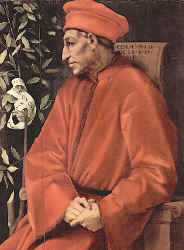
Cosimo
the Elder |
|
|
|
The elder son of Piero, Lorenzo (born in 1449) was destined to a brief but intense life that would go down in the history of Florence and Italy. Lorenzo the Magnificent is,
without doubt, the most important and significant member of the Medici family from all points of view. He was one of the great leaders of the Italy of his time, which in Florence witnessed
an extraordinary flowering of intellectual activities. He was a politician, and a man of power and culture.
Lorenzo began his public life very early and he succeeded his father when he was not yet twenty-one.
Immediately, he had to face difficult situations such as financial problems, conspiracies, relations with the
Papacy, with Kings and Princes of the other countries within Italy and outside. Nevertheless, slowly the "balance of power" that Lorenzo maintained with Milan, Venice and Naples reinforced the
Florentine position, and wise economic measures improved the family finances. But Lorenzo's genius went further than this: he continued his family's traditional patronage of artists, opening his house and gardens to the younger ones. First Leonardo
and then Michelangelo and many others such as Botticelli, Filippino Lippi turned to him for aid and protection.
|
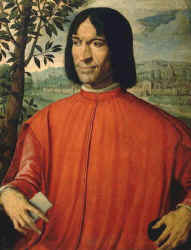
Lorenzo
il Magnifico |
At the time of Lorenzo the Magnificent, precisely in 1485, Girolamo Savonarola, a Dominican from the convent of San Marco began to seduce the Florentines with his prophetic language. He spoke of the Apocalypse and of the dreadful God, first from the pulpit of San Marco and then from that of the cathedral. Although it had been Lorenzo who had brought the Dominican back from exile in Bologna, Savonarola's preaching soon took on a tone of implacable accusation against his benefactor.
The friar accused Lorenzo publicly and unequivocally of ruining the state and squandering the wealth of the people deposited in the public coffers. Those who attempted to appease the spirit of the friar received the answer, "I do not care. But let (the Magnificent) know that I am a foreigner and he is a citizen and the first of the city: I am to stay and he is to go: I shall stay and not he." Many saw in these words a prophesy of Lorenzo's death, like the lightning-bolt that had struck Brunelleschi's dome a few months before his death. Accounts of this last meeting between Lorenzo the Magnificent and Savonarola differ, but one may suppose, or hope, that in the end the friar remembered above all his duties as a priest. Lorenzo died peacefully in the night between April 8 and 9, 1492 in the Villa of Careggi. Florence was deeply shaken by his death which left an immense void in the world.
Two years after Lorenzo's death, his eldest son Piero, called the "unfortunate", was exiled from Florence for his political "incapacity" and only after 18 years
could the Medici family return to its home town.
The fluctuating fortunes of the Medici
In 1512, Giuliano, the youngest son of Lorenzo the Magnificent, later called the
Duc de Nemours, made his way back to Florence and governed the city on behalf of his brother
Giovanni, then still a Cardinal, but elected Pope one year later in 1513, taking the Name of Leo X.
From Lorenzo the Magnificent, his father, the new pope had inherited a taste for art and the refined generosity of a great patron, perhaps his only real virtue. His pontificate, which lasted only nine years, would be the most tormented, as a consequence of the indiscriminate sale of
indulgences, and would witness the spread through much of Northern Europe of the theories of Martin Luther and his followers.
Giuliano, Duc de Nemours, died childless in 1516.
Lorenzo, Duke of Urbino, son of Piero (grandson of Lorenzo "the unfortunate") married a beautiful
French young girl, Madeleine de la Tour d'Auvergne. Both of them died very young and they left a newborn baby girl,
Caterina. A great destiny awaited her, for at the age of fourteen she would become dauphine of France and later the queen of France. Thus the legitimate branch of the Cafaggiolo Medici came to on end.
Upon the death of Lorenzo, Duke of Urbino, the acknowledged head of the Medici family was
Cardinal Giulio, the illegitimate son of Giuliano, the brother of Lorenzo the Magnificent who had been killed in the Pazzi Conspiracy, who had been brought up with his cousins by Lorenzo and his wife. He would become
Pope, the second Medici pontiff in 1523, following the death of Adrian VI. Like a good Medici, he was an open-minded and intelligent patron of the arts as a cardinal and as pope.
His papacy, however, was one of the most tumultuous of the XVI century. It came during the worst period of the
war between Francis I of France and Charles V of Spain which led to the Sack of Rome (1527). The other serious problem Clemente VII had to
face was the English Schism.
|
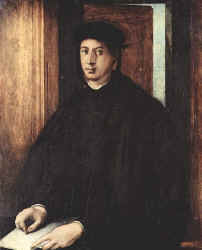
Alessandro Il Moro
|
Following the Sack of Rome, it had seemed that control of Florence would again escape the hands of the Medici, for the city had chosen
Almighty God as its king and declared itself a "Republic-city". But after less than three years, Charles V of Spain brought the short-lived republic a
Duke, the bastard Alessandro, perhaps the illegitimate son of the pope when Clement was a cardinal. It was said that his mother was a negro or mulatto, a supposition born out by the
pronounced negroid features of the young Alessandro, which gave him his nickname,
"il Moro", the Moor.
Il Moro was assassinated in January 1537 and with his death the principal branch of the Medici family, the
Cafaggiolo,
ceased to be the protagonists in the changing fortunes of the family and their struggle for power
in Florence would be conducted, henceforth, by the junior branch of the Medici, the
"Popolani", descended from Lorenzo, the brother of Cosimo the Elder, who was nicknamed
"Popolano"
because of his undisguised sympathy for democracy.
|
|
The most outstanding of the Popolani was Cosimo, the son of Giovanni dalle Bande Nere and Maria
Salviati, who at this time
was preparing to assume control of the city. Cosimo was the first true Duke of Florence, later created
Grand Duke by Pope Pius V, and it was he who laid the foundations of the Medician principality that was to continue without interruption for the next two centuries. Cosimo extended his dominion to the whole of
Tuscany. In April 1555, after a ruthless siege, he subdued his most implacable enemy, the Republic of
Sienna
and when in 1559
Montalcino
also surrendered to him, his campaign was complete and Tuscany had become a single unified state.
His military conquests over, Cosimo proved his true greatness in his peacetime achievements. At his instigation work was begun on the construction of the port of Livorno (Leghorn); methods of
agriculture were improved by the use of the most modern equipment then available, the country areas were repopulated, and even in the
Maremma region
redevelopment projects were attempted. New works of art and architecture enriched the cities of Tuscany, and not just Florence, the capital.
|
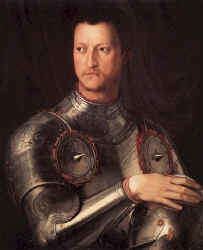
Cosimo I
|
|
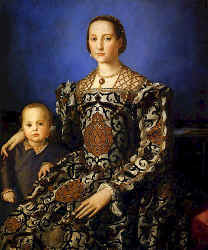
Eleonora of
Toledo
|
Eleonora of
Toledo was a member of the Spanish Aragón family, the daughter of the Viceroy of
Naples, Don Pedro Álvarez de Toledo.
Her marriage to Cosimo I in 1539 was arranged for dynastic reasons. Eleonora, through her father, provided the Medici with a powerful link to Spain, at that time ultimately controlling Florence. The union provided Cosimo I with the opportunity to show sufficient loyalty and trust in Spain for the withdrawal of Spanish troops from the province. However, Florentine politics were not Eleonora's only attraction to the Medici, new to their royal status. Her Aragón pedigree placed the Medici on an equal footing with their fellow European sovereigns.
Eleonora and Cosimo had many children, including eight sons, while before this time the Medici line had been in danger of becoming extinct. Thus by providing an heir, as well as through her daughters' marriages into other ruling and noble families of Italy, she was able to inaugurate an era of strength and stability in Tuscany. Two of her sons, Francesco and
Ferdinando, succeeded as grand Dukes of Tuscany.
During her marriage, despite her initial unpopularity as a Spaniard, she gained great influence in Florence, she encouraged the arts and was patron to many of the most notable artists of the age. A pious woman, she encouraged the Jesuit order to settle in Florence. She also founded many new churches in the city. She was interested in agriculture and business, helping to expand and increase not only the profitability of the vast Medici estates, but also, through her charitable interests, the lot of the peasantry.
Eleonora di Toledo died of malaria with two of her sons at Pisa in 1562.
|
The Duchy of Florence became a Granduchy, by order of the Emperor, and Cosimo established his absolute despotic control over the entire
region. He was anything but a democrat and showed this most clearly by transferring his court from the Medici palace on via Larga to
the Palazzo Vecchio, which had been the centre of civic power since earliest
mediaeval times. In 1539 he married Eleonora, the daughter of the viceroy of
Naples, Don Pedro of Toledo, who
bore him a large family.
Francesco, the successor of Cosimo (who died in 1574 at the age of 54), was an introverted man, gloomy
and much given to silence, definitely not as good as his father had been. What is more, he was distracted by very different interests, particularly scientific and
alchemical studies. He was also distracted by an intense love-affair with a beautiful
young Venetian lady, Bianca Cappello, whom he married after his official wife Joanna of Austria passed away.
Both Francesco and Bianca died in 1582, mysteriously one after the other in their Villa at Poggio a Caiano and since Francesco's only son, little Don Filippo, had
died too, the only heir of the Medici family was Francesco's brother, Cardinal Ferdinando.
He had been destined to the cardinalship in the tradition of the great Italian families. The cardinal, who had taken neither his vows nor holy orders though he lived much of the time in Rome in his magnificent villa on the Pincio hill, abandoned his cardinal's hat and became the third grand duke of Tuscany. After his father Cosimo, who had created the Duchy of Tuscany as a political entity, Ferdinando was undoubtedly the best of the Medici princes. Intelligent, prudent and well-balanced, he had a strong sense of family dignity and was well versed in the art of good government.
His personal coat-of-arms, a swarm of bees around the queen bee without a sting and the two mottoes, Maiestate tantum and Pacis et finium tutela, signify his
intolerance of all forms of violence (the only exception being his dislike of Bianca Cappello). With just the right measures of decorum, wisdom, and intelligence, Ferdinando returned the life of the grand duchy to a state of tranquility after the general shock of the scandal of Francesco's love for the beautiful Bianca.
Ferdinando dei Medici died suddenly on February 7, 1609, and his reign can be considered the high point of the age of the
Grand Dukes. He ruled as a wise prince. His reign was peaceful and he showed concern both for the welfare of his people and for the reputation of the state. With the help of his wife, Christine of Lorraine, he developed the life of the court so that it stood as an example of morality,
grace and good taste.
Cosimo II and Galileo Galilei
Ferdinando's successor was his son Cosimo II: the first act of the new Grand Duke, Cosimo II, was an error. He closed the Medici bank and would have nothing more to do with any kind of commercial activity, arguing that involvement in business was degrading for a prince, when in fact precisely this had been the principal source of the great family wealth.
During the reigns of Cosimo I, Francesco, and Ferdinando, the bank had continued to flourish, providing an inexhaustible source of funds that had been available to emperors and
monarchs. Now instead expenditures increased and income suddenly stopped.
There was also a conflict in the family between Cosimo's wife Maria Magdalena (Austrian) and his mother Christine (French), as they were each determined on a different political course: Christine would continue to feel the ties of her native France; Maria Magdalena, a Hapsburg, was completely taken up with the idea of a
Spanish-Imperial alliance. The brief life of Cosimo II was not an easy one, with the continual discord between the two grand
duchesses. Later on their conflict worsened when both became regents on behalf of the young Ferdinando.
Perhaps owing to his poor health and to the free hand allowed to his wife in politics, as a result of which Tuscany was submitted to Spanish domination, Cosimo II almost
completely neglected the government of his state. He also shunned all forms of artistic patronage, contrary to the traditions of his family. His death was not mourned by the people of Florence, who had hardly known, let alone loved him. His sole merit (by no means a trifling one) was to have given shelter to
Galileo Galilei, at a time when that eminent scientist was fleeing from persecution by the Inquisition in Padua. Cosimo gave Galileo a teaching position in the University of Florence and allowed him to continue his scientific research undaunted by persecution.
Ferdinando II and the Medicean Academy of Experimental Science
At the time of Cosimo's II death, his son Ferdinando was only eleven years old. His grandmother Christine and his mother Maria Magdalena took on the regency together, in accordance with the wishes Cosimo II expressed in his last will and testament.
The grand duchesses were full of good intentions, but of limited intelligence. In addition, they held radically opposed political views. Their main interest was to turn the court into an increasingly ostentatious and luxurious place, and to this end they plundered the Medici coffers, which Cosimo II had already depleted considerably and which were no longer replenished by income from the family bank. Both women were very devout, not to say bigoted, and set about increasing the number of religious institutions, monks,
nuns and priests until a considerable proportion of the civilian population belonged to religious orders of one kind or another.
Ferdinando was a mild man, oppressed by the conflicting influences of his grandmother and mother, which accentuated the weakness and indecisiveness in his character.
Only after the death of Christine of Lorraine, did the Grand Duchy of Ferdinando II
see a last burst of activity, during which Ferdinando attempted to weaken the all-pervading power of the clergy and diminish the authority of the
Inquisition. At the same time, following the family tradition, he encouraged the arts and sciences. However his policies as a ruler had been weak and uncertain, above all dominated by Spain and Austria and extremely oppressive for his subjects whatever their social standing.
Unbelievably crushing levies were exacted on everything and everybody, and a tenth of all the revenue from this
taxation went straight into the coffers of the Grand Duke, who was particularly avaricious and oppressed by the costly magnificence of life at court in keeping with the directives of his wife, the grand duchess Vittoria della Rovere.
Ferdinando II had three brothers: Cardinal Giovanni Carlo, a lover of sybaritic life, a patron and art collector who occasionally acted as adviser to his brother; Mattias, a professional soldier; and
Leopoldo.
Cosimo III and the decline of the Grand Duchy
When Ferdinando II died, his son Cosimo III (1642-1723) became Grand Duke. His long reign, which lasted for fifty-three years, was a positive disaster for the state of Tuscany and for the Medici dynasty. Already overly devout in his own right, he had been dominated by the bigotry and vanity of his mother, since his father, whose weakness was indolence, had not asserted his authority in the child's upbringing.
Cosimo spent long hours in prayer and visited monasteries and sanctuaries where he proved a generous and devout guest. Priests, friars and monks proliferated in Florence, absorbed in their psalms,
prayers and hymns while the Tuscan state was losing its former brilliance to a steady and reactionary decline for which its ruler was entirely to blame. It is small wonder that Tuscany became the victim of terrible economic recession, as no attention was paid to any of the innovations being put into practice in other Italian states.
Even the arts and sciences were neglected in Florence, as artists and scientists left a Tuscany caught in the stranglehold of the clergy. Pisa,
Siena and Livorno were reduced to insignificant, depressed cities and Florence's reputation was based exclusively on its illustrious past, which made the present seem even more dreary by comparison.
Cosimo III also made a serious mistake over his choice of a wife: he married Marguerite Louise of Orléans, cousin of Louis XIV, the
Sun King. She was of a rare beauty, while Cosimo was corpulent from childhood and he was diametrically opposed to his young bride in character and attitude to life. The marriage
immediately turned stormy. Nevertheless, the young couple had three children: Ferdinando, Anna Maria Luisa and Gian Gastone.
Of the three children, Grand Prince Ferdinando was a pleasant-looking boy, intelligent and with a natural feeling for beauty and culture. Nevertheless he grew into a dissolute and intemperate man and died before his father. He married the sixteen years old Violante of Baviera but they had no children.
Gian Gastone and the end of the dynasty of the Medici
Gian Gastone was a solitary young man who spent most of his time in a refuge he had in the Boboli Gardens, absorbed in his studies of plants and flowers and his collection of precious objects and beautiful things. Perhaps he had some particular tendency; certainly he suffered from a deep and inexplicable melancholy. He had been
neglected by his grandmother and mother and father, ignored by his elder brother, Ferdinando, by the court and by the people of Florence. But when his brother died, Gian Gastone became the only hope for the continuation of the Medici name. He was then forced
into the terrible marriage his father Cosimo III and his sister Anna Maria Ludovica arranged for him. He married Anna Maria Franziska, an
immensely fat, twenty-three year old lady, the daughter of the Duke of Saxony and Lauenburg and widow of Palatine Count Philip of Neuberg. The marriage was a disaster from the start, based as it was on lack of understanding, repulsion and a kind of dejected resignation on part of Gian Gastone.
No child was born from this marriage and obviously there was no hope for a Medici heir. Gian Gastone became Grand Duke of Florence at the age of
52, and he appeared increasingly tired and old with each day that passed. His indolence had become proverbial, and he totally lacked the will to reign. He was not interested in power, and he would have been perfectly happy to continue his pointless life without it. As soon as he became
Grand Duke, he showed his hostility towards his sister, whose intrigues had been the principal cause of the failure of his marriage. He attempted also to change life at court: his retinue, for example, which was smaller, was to dress in the French manner. He abolished the
taxes inflicted on the Jews, Turks, Lutherans and Calvinists who converted to Catholicism, and he abolished the political espionage instituted by his father. The people of Florence grew increasingly fond of the new
Grand Duke because he abolished the death penalty and lowered the price of grain.
Gian Gastone now sought above all to hand the Grand Duchy over to a family that could be expected to govern
it wisely without oppressing the citizens, who were to be considered and treated humanely. Perhaps he was not misguided in accepting the Lorraine family and thereby showing himself to be an enlightened and open-minded prince. When he died on July 8, 1737, he
evoked a deep sense of loss among the people, who had seen little of him but nonetheless felt that
he was closer to them than his father, Cosimo III, had been.
Anna Maria Luisa and the 'Convention of the Family'
Anna Maria Luisa the second child of Cosimo III and Marguerite Louise of Orléans, the favourite of her father who found in her that balance of affection he would never have from his wife. It is known that she was a striking child, dark,
intelligent and vivacious.
Anna Maria clearly had a cosier and happier childhood and a stronger and more balanced character, for she was sure of herself and of what she wanted. Like her grandmother, she gave a serious direction to her life, from which she never
wavered and which she based on solid religious foundations, although in later years her devotion became bigoted and superficial. She was clean and careful by nature,
something quite rare in those days. She was well versed in modern languages, studied Latin, painted
well and grew flowers, but above all she loved music, like her siblings - perhaps the only positive inheritance from her mother.
Cosimo III arranged for her a marriage with the palatine elector of the Rhein, Johann Wilhelm of Saxony. Thus Anna Maria Luisa found herself in a foreign country amid new customs and new people that only with the time would become dear and familiar to her. Only after the death of her husband
did she cross the borders of Tuscany after having been away for twenty-six years. In Florence she was welcomed by new cannon salvoes from the Belvedere fortress fired (perhaps for the only time) from the cannon of San Paolo, now in the Bargello, while all the bells rang. Cosimo
III assigned her the Meridiana apartment at the Pitti, where her grandmother had lived and where she herself had passed many days of her childhood. Freed of the impending nightmare of the Medici court during the years of her stay in the Palatinate, she settled back into it, leaving it only to gather herself in prayer.
We can image her as severe, distant and deliberately closed to affection, which she allowed only to her father. With the death of Cosimo III on October 31, 1723, Anna Maria Luisa's life became still sadder, more solitary and more withdrawn. Gian Gastone, upon becoming
Grand Duke, also lived in the palace, but the brother and sister never encountered one another. Gian Gastone died on July 9, 1737.
Now Anna Maria Luisa was the last of her family and remained alone in the great Pitti palace. She loved Florence, whose beauty she considered unique and for which she longed terribly during the twenty-six years of her happy (but childless) marriage in a distant
northern land. Anna Maria Luisa's greatest achievement was undoubtedly the "Treaty or Convention of the Family", concluded with her successors the Grand Dukes of Lorraine on October 31, 1737, by which all the art treasures belonging to the Medici family became property of the city of Florence museums for the enjoyment of people from all over the world.
|





